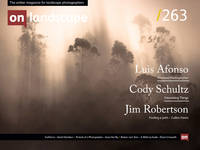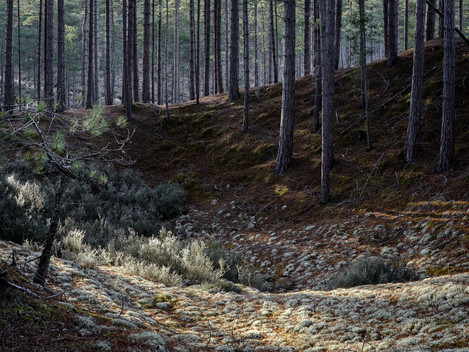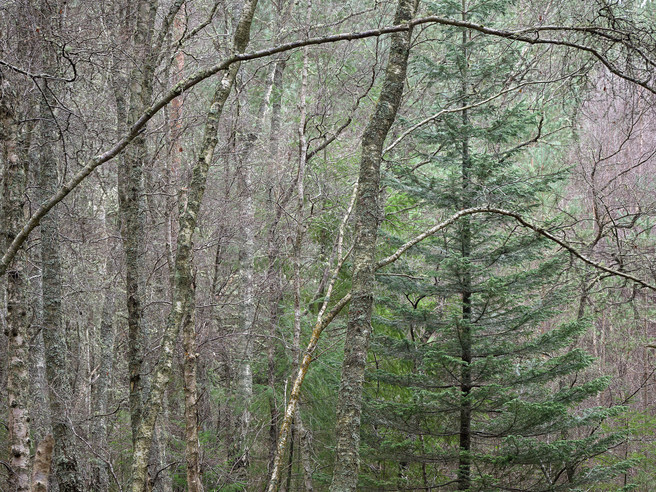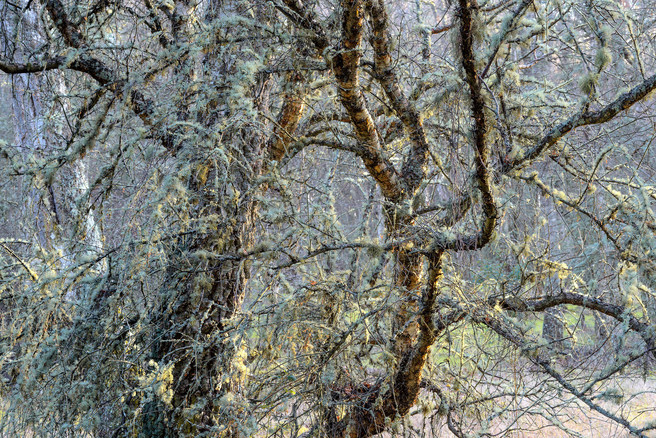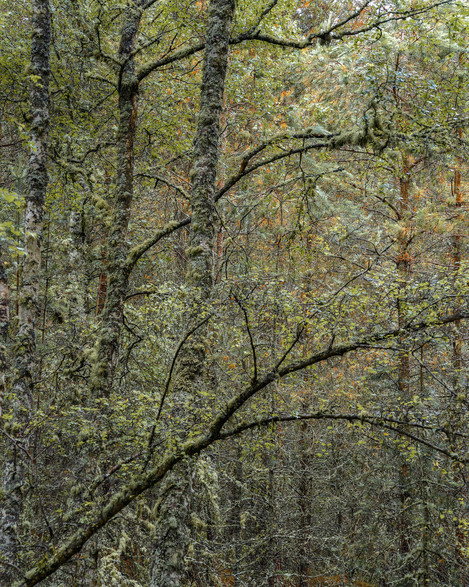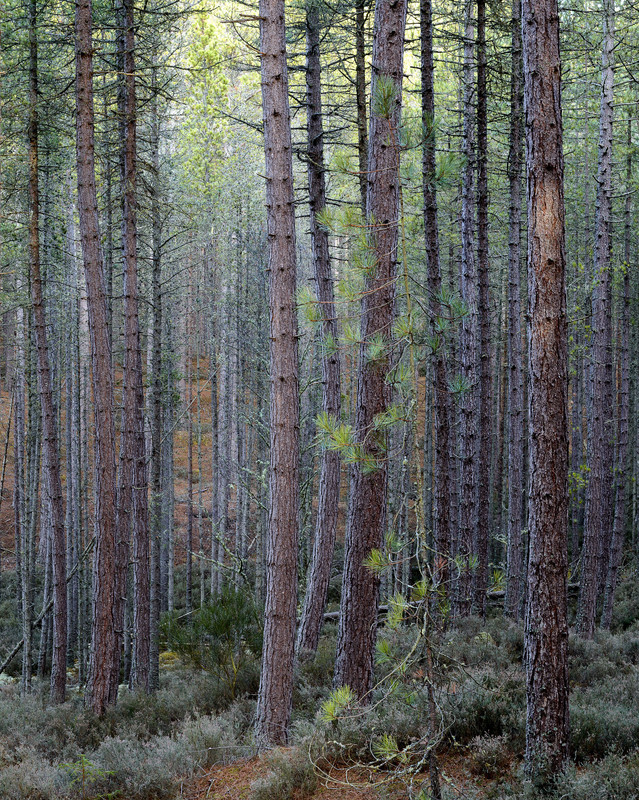An exploration

Jim Robertson
Landscape photographer based in the North East of Scotland with a leaning towards intimate landscapes. Retired designer.
There will be few, if any, subscribers to ‘On Landscape’ who are not aware of ‘The Landscape’ by Paul Wakefield (read our review of the book and our interview with Paul). I ordered it when it was first published in 2014, and now, some eight years later, my copy has that well read look to it. Paul’s work first came to my attention actually when, prior to 2014, I had bought a second hand copy of ‘Scotland: A Place Of Visions’ by Jan Morris and Paul Wakefield. I noticed in that book that Paul had included photographs made in Culbin Forest, which is located mostly in Moray in the North East of Scotland.
That interested me immediately as I live some 40 minutes by car from Culbin Forest and had been wandering the area now and again since I became aware of it in my early twenties. That’s more than forty years ago now. I had also established an interest in photography at that time, but it wasn’t until much later that I had developed an interest in intimate landscape photography and had begun to explore the local forests photographically circa 2014.
Culbin forest covers approximately 3,500 ha and forms part of the SSSI ‘Culbin Sands, Culbin Forest and Findhorn Bay’, which in turn covers some 5,000 ha. The forest was established on a huge dune structure known as Culbin Sands, an area surrounded by mystery and intrigue. The history goes back to the beginning of the 13th century with the actual destruction of the Culbin estate by wind blown sand happening in 1694. Did a substantial community comprised of 16 farms really vanish overnight in a sandstorm in the late 17th century? The book 'The Culbin Sands - A Mystery Unravelled' by Sinclair Ross, published in 1992 (a PDF version is available), goes some way in establishing what actually happened at Culbin. The Forestry Commission started to look at the area circa 1921. Marram grasses were replanted in order that some of the sand could be slowly stabilised before tree planting began, and today the resulting huge working forest is also managed so as to provide a key recreational resource for Forres, Nairn and the surrounding areas. The dune system is the largest in Britain, and substantial areas of that system have not been over-planted. Shingle ridges run parallel to the forest for 7km along the coast.
I had no objectives in mind really when I started to explore Culbin Forest with a camera, and thirteen years later, that is still true today. I photographed what grabbed my attention. Purposely some of the photographs were taken in overcast conditions in order to prevent over-exposing lichens and mosses. The area virtually never gets mist, and any sea haars burn off rapidly. Misty tree opportunities are therefore non existent unless one can substitute mist for rain. Snow is also a rare occurrence these days, but rainfall seems to be on the increase. The forestry access roads are well maintained, but one has to wander away from the tracks to be in the real forest and really experience it.
To maybe sit and watch for any wildlife. Smell the forest or listen or contemplate the living forest above and beneath one’s feet. Perhaps even to watch the wood ants climbing over those feet. They are never far away! The dune structure on which the forest was planted is, to a great extent, still apparent and can be over 30 metres in height in places. Culbin is full of surprises. In no way can it be described as being wild. However, even though it may be a huge working forest, it is also a sensitive area. If you plan a visit, please take care of walking off the tracks as rare plants, including national and regional rareties, can be found in Culbin. Likewise, rare lichens and fungi also exist in the fragile and diverse habitats. One species of fungi is not found at any other location in Britain.
One of the subjects I discussed with Paul was access, and we both agreed that walking provided the best opportunities for seeing photographs. I remember him telling me that “Culbin is a time consuming place.” He wasn’t wrong! I used to see Culbin as an ongoing project, a live project and one where I would add and cull images regularly. However, enter Guy Tal. In his book titled 'More Than A Rock' (p 107) he writes about projects and how he prefers the term explorations rather than projects. His point being that a project really requires to be completed for it to perhaps be seen as a success. An exploration, however is just that as he explains in his words, “I find ample and sustained reward in merely being engaged in something that interests and fascinates me: a journey that is more important than any preconceived destination.” I can’t say it better than that! Who could?
I will never come remotely close to exploring all of the forest but I accepted that a long time ago. Now, if the light is quiet preferably, I sometimes still make my way to Culbin and wander the forest and look to see what will grab my attention or revisit favourite locations just to see what has changed. I might even take a photograph or two! ‘Finding a path – Culbin Forest’. It’s an exploration.
Thank you to Mark Reeve, Planning forester for Moray & Aberdeenshire FD, from Forestry Commission Scotland, for providing me with additional information about Culbin Forest. And finally, thank you to Paul Wakefield and Guy Tal for their inspiration and generosity.
References
‘The Landscape’ - Paul Wakefield. Published by Eddie Ephraums 2014., ISBN 10: 095647649X ISBN 13:9780956476494.
‘Scotland: A Place Of Visions’ - Jan Morris, Paul Wakefield. Published by Aurum Press 01/10/1986 ISBN 10: 0948149191 ISBN 13: 9780948149191.
‘More Than a Rock: Essays on Art, Creativity, Photography, Nature, and Life’. - Guy Tal. Published by Rocky Nook 15/02/2021
ISBN 10:1681986833.
‘The Culbin Sands - A Mystery Unravelled' - Sinclair Ross. Published by University of Aberdeen Centre for Scottish Studies 1992.
ISBN 10: 0906265169 and ISBN 13: 9780906265161.
The Scottish Society For Northern Studies provides us with a link to this pdf version of the above https://www.ssns.org.uk/wp-content/uploads/2019/10/10_Ross_Moray_1993_pp_187-204.pdf
Additional information about the history of Culbin forest 1921 - 1951 can be found by following this link https://www.forestresearch.gov.uk/publications/archive-history-of-culbin-forest-1921-1951/
For those readers requiring further information on the work of the Forestry Commission in establishing Culbin Forest I would draw your attention to ‘The Culbin Story’ which is archive video footage from 1955. As the introduction informs us "This archive film was made in 1955 - just as the vast task of establishing a forest at Culbin was coming to an end. It tells the story of the people of Culbin being driven from the land by advancing sand and then the mammoth effort by the Forestry Commission to establish the forest we see today". The films are edited by I Anderson and narrated by J Urquhart.
I would also draw the attention of any potential visitors to the forest, and indeed forests in general, to the Forestry Research publication Lyme Disease. https://www.forestresearch.gov.uk/tools-and-resources/fthr/lyme-disease/

